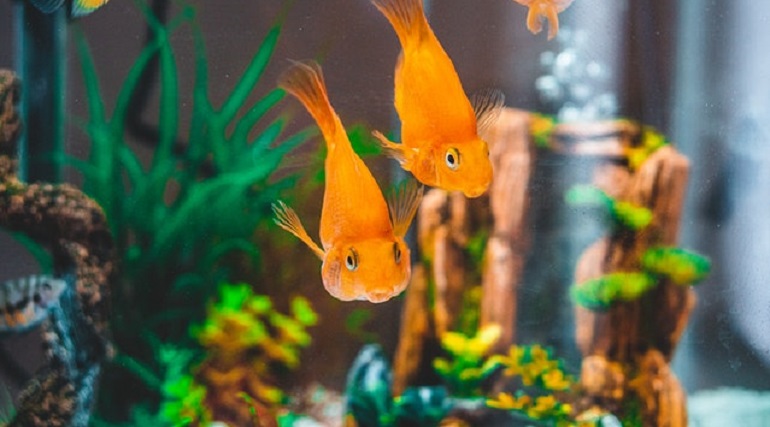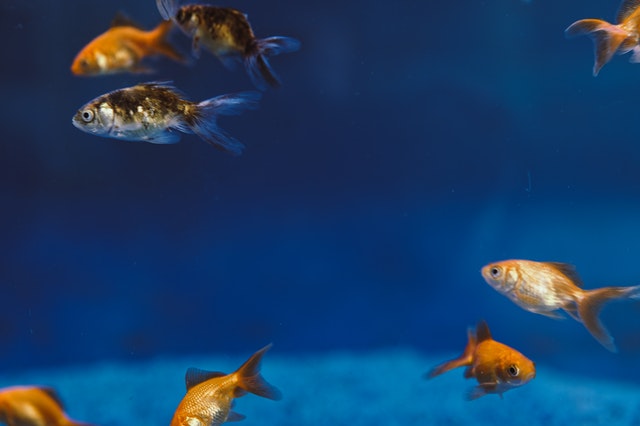Answer: The scientific name of goldfish is Carassius auratus.
You will love to read more about Goldfish:
What is the scientific name of goldfish?
I’ll give you two guesses.
Can you answer that without looking it up?
No?
No worries! I would’ve been pleasantly surprised if you had known!
What is the scientific name of goldfish?
In case you’re wondering, the scientific name of goldfish is actually “Carassius auratus”. While most of you may not have known the scientific name, it’s almost guaranteed that you are familiar with its common name- ‘goldfish’. It’s also more than likely that you have seen one of these iridescent oranges (or red, or yellow, or black…) fellows darting about in the tank of someone’s office, classroom, or maybe even in an indoor or outdoor pond.
History of Goldfish

Goldfish have existed for thousands of years in their role as decorative “pets”. Their history is by no means totally linear when it comes to their role as pets, or when it comes to their physical characteristics, for that matter. The goldfish’s history can be traced back to Eastern China where we find them as the domesticated descendants of the crucian carp, a silver-colored fish that has long been farmed as food. It was during China’s Tang Dynasty of AD 618 to 907 that we see goldfish’s status as an ornamental fish truly solidified: People would populate their ornamental ponds and water gardens with goldfish based on their color, and, most likely, other physical characteristics of the fish.
Types of goldfish

There is truly an endless array of goldfish. This is in large part because of the breeding efforts of humans from at least as far back as the Tang Dynasty. The carp variant that we know as “goldfish” was bred for its red and gold color- a mutation that made them appear quite different from the gray-silver color of your standard carp. Interestingly, during the Song Dynasty in China (960-1279), which may have been the height of the popularity of decorative goldfish in China, commoners were forbidden from owning the gold-colored goldfish because gold was considered a color only fitting for those of royal standing.
Opinions vary about the number of varieties of goldfish that exist, but estimates put the number anywhere from 125 different breeds up to 300.
Goldfish characteristics
Selective breeding means that goldish vary in size, color (orange, gold, red, black, white, “calico” or spotted; ); the shape of their bodies (egg-shaped; streamlined); fin configuration (tri-lobed tail fin, flowy tail; dorsal fin, no dorsal fin); and eye configuration (protruding eyes; upturned eyes; “normal” eyes).
While in captivity (i.e. a fishtank), goldfish generally grow to no more than two to four inches long, but once released out into nature they can grow up to twelve inches long, on average, and sometimes even more.
In the city of Burnsville, Minnesota, goldfish have become an invasive species. People have released their pet goldfish into the ponds and lakes there, probably not realizing that goldfish grow in size to match their environment, and this has caused disruptions to the ecosystem. Those cute, little two to four-inch goldfish in your fishtank can more than quadruple in size out in the wild and disrupt plant life and water quality.
Fancy vs. not fancy
When speaking about the varieties of goldfish, “fancy” is a term that you will hear come up time and time again when referring to goldfish. Fancy goldfish are indeed goldfish, though it might not always be so clear by looking at them. These goldfish often have an egg-shaped body and double fins, not to mention a variety of other physical characteristics that distinguish them from their less “fancy” goldfish counterparts. All of the extra physical accoutrements are probably what make them slower, less hardy, but quite peaceful varieties of goldfish.
Names of goldfish
Among the most popular varieties of goldfish are:
- The common goldfish- streamlined, orange, and differs from its carp relative in size only. Relatively easy to care for.
- Black Moor- black in color and “fancy”, the Black Moor is relatively hardy.
- BubbleEye- A delicate, calico-colored goldfish named for the bubble protrusions under each eye.
- Celestial- aptly named because its eyes are locked in an upward gaze.
- Comet- orange in color with feathery white fins; the Comet goldfish likely earned its name for its zippy movements.
- Fantail- fancy, but hardy, the Fantail has a split caudal fin.
- LionHead- a very slow variety of goldfish due to its missing dorsal fin.
- Oranda- also known as the Red Cap, is a fancy variety with a distinctive red-orange dome on top of its head.
- Ryukin- egg-shaped and humped yet still relatively streamlined, the Ryukin make a good choice for new goldfish owners due to hardiness.
- Shubunkin- a very popular variety of goldfish that originated in Japan, the Shubunkin is a calico-colored mix of a common goldfish, a Telescope goldfish, and a Comet goldfish.
- Telescope- Speaking of Telescope goldfish, this variety earned its name because of its large, protruding eyes.
- Veiltail- is very similar in shape to the Ryukin, the Veiltail is a stunning golden brown color.
- Blue Oranda- this is a blue goldfish with the distinctive “cap” of the Oranda. This is an active fish that is easy to care for.
Where do goldfish live?
Goldfish are considered a freshwater fish, so freshwater is where they thrive, whether it be in a fishtank or out in the wild. In the wild, they are most comfortable in temperate ponds, lakes, and streams.
Generally, the hardiness of the goldfish depends on the genetic characteristics that may be considered helpful or not-so-helpful when it comes to surviving certain conditions.
For example, common goldfish are more streamlined in shape and thus faster than fancy goldfish, which means that it may be easier for them to arrive at a food source or withstand changes in temperature.
The lifespan of goldfish
Pet goldfish have been known to live up to twenty-five to thirty years, though this is not necessarily considered typical. Ten to fifteen years is the average lifespan of a goldfish in captivity. In the wild, goldfish have been known to live from twenty to forty years on average.
With its 1000+ year history- and counting- goldfish are one of the world’s oldest domesticated fish and exports from the East. But did you know that the annual sale of nearly 500,000 goldfish every year make it the world’s most popular pet as well? Its versatility, hardiness, and sociability make goldfish a treasured pet that is here to stay.
k_blackwell5

